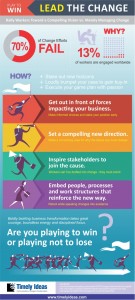
Rallying workers toward a compelling vision beats merely managing change.
It’s been widely purported 70% of Change Initiatives fail to hit their targets and just 13% of workers are engaged worldwide. No wonder Senior Leaders are clamoring to “transform” their organizations. “Business as Usual” just isn’t cutting it anymore. Thanks to globalization, shifts in workforce composition and ever advancing technologies, businesses are being radically redefined – whether they like it or not – at dizzying rates. Standing still gets you nowhere – Fast.
What’s a Leader to Do? To win, Leaders must boldly stake out new horizons, loudly trumpet their business case to gain buy-in and execute their game plan with passion. Anything less – such as trying to minimize the effects of change – amounts to damage control and “playing not to lose”. But Leaders Beware: Boldly leading change is not an easy task, nor for the faint of heart. It requires courage, grit, stamina and a deep capacity for connecting with workers.
How Do the Winners Do It? Successful Leaders I’ve seen – while differing in styles – do 4 things really well:
They get out in front of forces impacting their business. They are wired to the business context of their company, discern key opportunities quickly and are decisive in staking early positions. They see what’s coming sooner and make informed choices. They are students of the game. This is not without risk. But successful leaders are comfortable performing in clutch situations and have confidence they, along with their supporting team, will be up to the task. The thought of “Losing” never enters the picture.
They shine at setting compelling new direction. Once they stake a position, successful leaders make a convincing business case for refocusing and why the status quo must change. They get the word out and are clear on expectations. They use a variety of touch points and channels to evangelize their cause. They stay on-point and repeat key messages on-line, off-line and in-person to reach time starved, distracted workers. Whether it’s a Town Hall, Video or Executive Update they are adept at tailoring their message to fit any size audience with impact.
They inspire constituents to join the cause. Workers cannot be drafted into change – they must enroll. Successful leaders are masters at drawing stakeholders into the conversation and getting them to take part. They “unfreeze” the existing organizational mindset and create engagement through frank discussion on why the status quo is no longer viable. This is crucial to gaining buy-in. Winners overcome resistance by engaging skeptics in open dialogue, clarifying issues and crystalizing the vision. They’re great story tellers and use simple metaphors to drive home key points and convert fence-sitters into believers.
They embed people, processes and work structures that reinforce the new way. Successful leaders don’t wait around – they start retooling while speaking changes into existence. They aren’t afraid to dismantle outdated business strategies, practices and resources that no longer fit. They put resources in the right places to create visible momentum and build a strong coalition. Such swift actions provide both symbolic and measurable evidence that the future has arrived. Most importantly, they lay the foundation for sustaining the new ways of working and making the changes stick.
Finding a Way to Win
None of this is straightforward nor without transitional pain. Setbacks are to be expected and mark opportunities to gain deeper traction. Successful change leaders, while acting with urgency, allow sufficient time for their game plan to gel and for followers to emerge.
Boldly tackling business transformation takes great courage, boundless energy and disciplined focus. The stakes are high. Are you playing to win or playing not to lose? The rewards can be game changing!
Related Links:
John Kotter: The Difference Between Change Management and Change Leadership
Management is Still Not Leadership
10 Principles of Leading Change Management
Most Change Initiatives Fail – But They Don’t Have To (Gallup 2013)
Grit: The Top Predictor of Success
